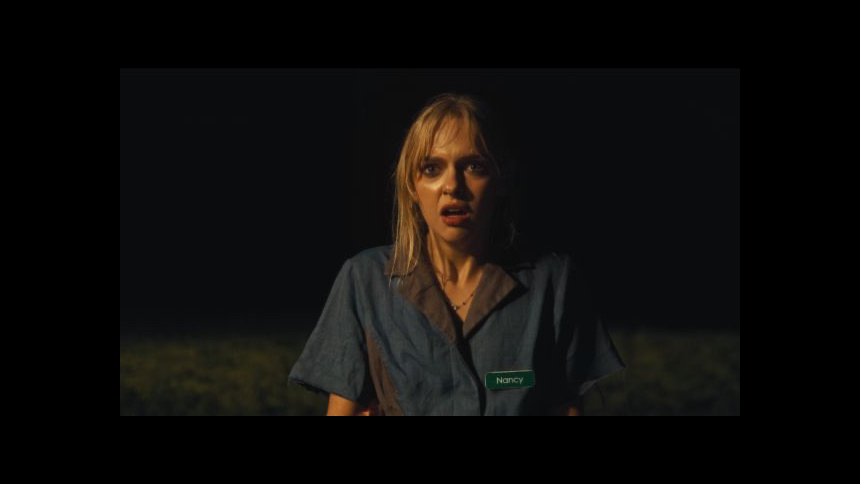Sitges 2023 Review: LAST STRAW, Taut Diner-Invasion Neo-Noir Thrills, But Doesn't Chill

The first feature-length film from writer Taylor Sardoni and director Alan Scott Neal, Last Straw answers a seemingly simple, if rarely asked, question: When is a home-invasion thriller not a home-invasion thriller?
The answer is just as simple, if also as rarely asked: When it’s not a home-invasion thriller, but a diner-invasion thriller. Swapping out a typical suburban home with a middle-of-nowhere diner open 24 hours automatically adds a level of novelty and originality to an otherwise tired, often repetitive, sub-genre. Whether that’ novelty and originality, however, qualifies as sufficient to recommend the Last Straw is another question altogether.
Last Straw opens on a close-up of a not quite old-school jukebox. It’s filled with CDs, not vinyl, but the close-up adds an ominous note, especially as Neal and cinematographer, Andrey Nikolaev retreat from the jukebox, revealing the aftermath of an incredibly violent night. Limp bodies lie prostrate, pools of blood coagulate, and an unseen, panicked voice calls 9-1-1 pleading for help, before flashing back 24 hours to methodically detail the identities of the victims and possible survivors, and how exactly they ended up on the floor of a diner.
The 24-hour rollback introduces Nancy Osborn (Jessica Belkin), a 20-year-old waitress, taking a roundabout way to an otherwise inconspicious diner, the Fat Bottom Bistro, owned and operated by her father, Edward (Jeremy Sisto). In either a show of good faith, a desperate act to keep his only child close by or both, Edward has promoted Nancy to manager, a role she doesn’t seem to want or even care about. Even worse, due to a shortage of staff, Edwards twists Nancy’s arm until she agrees to work the graveyard shift alone.
On its own, a woman alone, a deserted diner, and things (or people) that go bump in the night easily qualifies as a terrific premise, especially for a low-budget thriller where thrills, not to mention scares, come fairly cheap. Add to that the promise of a home-invasion, correction diner-invasion thriller turning, as expected, into survival horror, and Last Straw is practically halfway toward convincing horror-friendly audiences to buy whatever it’s selling.
Neal and Sardoni appropriately tighten the screws on Nancy and the hell night that awaits her by almost immediately introducing a gang of obnoxious, moped-riding teens. In the daylight, they’re a nuisance, preening and insulting Nancy with sexist, misogynistic humor to win bro-points with each other.
Potential trouble also comes, though, from the diner’s all-male staff. One in particular, Jake Collins (Taylor Kowalski), resents Nancy and the nepotism that gave her the promotion he feels he's always deserved. Another waiter, Bobby (Joji Otani-Hansen), swoons whenever Nancy's around, but given Nancy’s perpetually negative experiences with toxic men, Bobby’s nice-guy facade might just be that, a facade hiding another male predator.
The contrast between Nancy and her repeated use of caustic language, less as a personality trait (i.e., mean girl) and more as a necessary self-defense mechanism, and the men, almost always operating in a pack, sets the stage for the “invasion” part of diner-invasion thriller to move into the foreground. Wearing masks and, at least initially, pranking Nancy to annoy and/or frighten her, the attacks gain in ferocity with each encounter, eventually leading to the initial scene, partially foreshadowing the fates of several characters.
Where most home-invasion thrillers simply amp up the tension and suspense, making escape less and less likely, Neal and Sardoni make the curious decision to stop the film halfway through for an extended flashback. While the flashback explains the who, what, and why behind the attacks on the diner and specifically on Nancy, it also puts the central story into suspended animation for what eventually starts to feel like an interminable amount of screen time. A surer pair of hands would have either dropped the flashback altogether, integrated it into the narrative chronologically, or fully embraced an elliptical storytelling approach.
It’s not a fatal flaw, but ultimately, still a consequential one. Once Last Straw leaves the flashback behind, it picks up momentum again, placing Nancy against seemingly insurmountable odds, the landline inactive, her cellphone apparently gone, and her father unreachable (inconveniently for Nancy, conveniently for the story itself). Per the familiar tropes of the sub-genre, the police prove to be ineffectual or even worse, completely useless, leaving Nancy, not home alone, but diner alone, forced to rely on her wits, experiences, and above all else, her survival instinct, to make it through the night.
Flashback aside, Last Straw unfolds in brisk, efficient, economical fashion, rarely wasting a moment or shot in furtherance of Nancy’s story. Rare for an indie film — or any film for that matter — Last Straw feels too short, leaving at least one or two set-pieces involving Nancy and the masked attackers offscreen. That, of course, was likely a function of time and budget, not imagination or ambition.
With an atypically on-point cast giving reasonably grounded performances, clean, crisp cinematography and editing to match, plus a minimalist synth-pop/chillwave score composed by Alan Palomo (Neon Indian), and Last Straw delivers a perfectly serviceable slice of roadside entertainment.
Last Straw screened last night at Sitges Film Festival and screens again today. It then screens Sunday, October 8, at Beyond Fest 2023.






